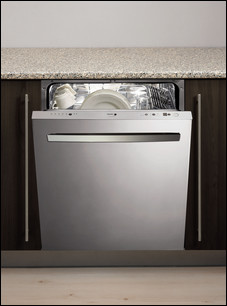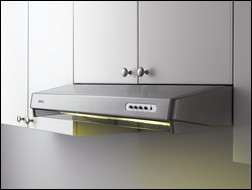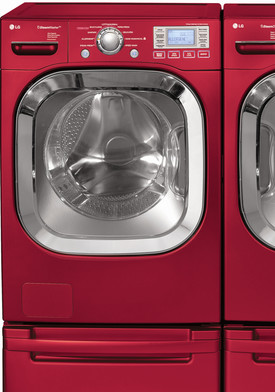The green movement has hit home—literally. More and more people are requesting earth-friendly options not only in the materials used to build their homes but the appliances that fuel their everyday lives.
 Whirlpool Corp.’s GreenKitchen is a vision of a greener future. |
Appliance manufacturers are answering the call with refrigerators, dishwashers and washing machines that use less water, less energy and do more in less time. These innovations are meeting a burgeoning demand, according to a Better Homes and Gardens April 2008 magazine survey. Today, more than half of so-called “home enthusiasts” want to be informed of the options available in green building and remodeling. And the younger you are, the more likely you’ll be interested in this trend. Two out of every three 20-somethings are thinking “green” when it comes to their homes.
Looking for the Energy Star seal is the easiest way to find energy-saving appliances. The Energy Star program is a joint effort by the U.S. Department of Energy and U.S. Environmental Protection Agency to create energy usage standards for appliances that help consumers save money and energy. Log on to their Web site and you can search for the most energy-efficient appliances in each category.
In addition to looking for the Energy Star label, here are some added ways to keep your energy bills low and your carbon footprint small.
Green Refrigeration
The first place to look when trying to save energy is the kitchen’s biggest guzzler: the refrigerator. If yours was purchased before 1993, odds are it uses twice as much energy as today’s Energy-Star rated refrigerators. And just as recently as April 2008, energy standards for refrigerators were further tightened, requiring current models to be at least 20 percent more efficient than the federal standard. The previous standard for an Energy Star rating was 15 percent.
 The Miele Independence Refrigerator is the most energy-efficient in its class. |
Energy Star rates the Miele Independence Refrigerator (Models 1811 and 1801) as the most energy-efficient in its class, using 33 percent less energy than the Energy Star requirement. This is accomplished with the help of a dual compressor system that features a dedicated cooling system for each interior compartment. Temperature controls are also available that keep milk at 40 degrees and fruits and vegetables at a chillier just-above-freezing state. This dual-temperature functionality keeps a variety of food fresh without wasting energy setting the entire fridge at the lower temperature.
The Miele fridge is relatively narrow at a width of 30 inches. Its small size contributes to its energy efficiency, another factor to consider when refrigerator shopping. You should also consider longevity. “If you buy a product that has a longer life cycle, then it will not go to the dump site as often,” says Carmen Mateo, kitchen designer with The Green Home Center in San Francisco, Calif. “Generally, the more expensive ones tend to last longer. The SubZero refrigerator, which is built like a tank, tends to last a minimum of 20 years.”
In addition to its Energy Star rating, SubZero touts the fact that all its appliances are U.S.-made, eliminating the environmental impact of international shipping, and all scrap metal from the production process is recycled.
Green Cleaning
Besides electricity, dishwashers, washers and dryers are all heavy users of another resource: water. Manufacturers are improving efficiency in these categories by reducing and finding new ways to use water.
 The Fagor Tall Tub Dishwasher conserves water by only adding fresh water as needed during the wash cycle. |
The Fagor Tall Tub Dishwasher has an eco-sensor that monitors water quality during the wash cycle and only adds fresh water as needed, reducing usage by up to 25 percent per load. LG uses steam instead of water in its dishwasher.
Steam is also making its way into the laundry category. LG’s SteamWasher uses less water and energy than standard washers. The companion SteamDryer features a SteamFresh cycle to reduce wrinkles, which saves the electricity needed to iron.
When choosing a washing machine, opting for an Energy-Star water-saving front-loader versus a top-loader with a central agitator will save you money. A standard clothes washer costs $1,310 per year to operate, whereas an Energy Star washer costs only $760 per year. And if you often wash less than a full load, a model that automatically senses load size can help. Washing in cold water saves the energy of heating the water and is a good option for clothing not heavily soiled. Bosch’s Nexxt Washers feature an ECOACTION option that decreases temperature and reduces energy usage up to 20 percent per load.
LG’s steam-powered washer and dryer conserve water while leaving clothes stain- and wrinkle-free. |
And because smaller units by their nature use less electricity, Seattle-based Green Kitchen Designer Molly McCabe recommends only buying as large a washer and dryer as you need. For McCabe, her husband and two children, Miele’s compact washing machine meets her family’s needs. “People want these massive units that can wash 16 pairs of jeans and I am like, ‘why?’” she asks. “I will level with you—I cannot put a queen-sized comforter in my machine. But instead I just send it out to the dry cleaner or the Laundromat and save by not having a large unit.”
Green Cooking
The key to saving energy while cooking is to cook quickly and focus the energy on heating your food and not your kitchen. LG’s Dual-Convection Electric Range pre-heats the oven 30 percent faster than standard models. And the convection feature ensures food is cooked evenly, which means you can limit how many times you need to open the oven door to check your roast.
Induction cook tops are eco-friendly because the cookware sits directly on the ceramic glass, eliminating the horizontal heat loss you get in a traditional gas range. “Induction is great because you use less power for venting and because it works so fast that you have something cooked in much less time,” says Mateo.
You can also look for the Energy Star label when purchasing ventilation hoods. McCabe’s favorite options in this category come from Zephyr Corp. and Broan-Nutone LLC’s Best Kitchen Ventilation line. The Zephyr ES1 under-cabinet ventilation hood, for example, meets the Energy Star standards by saving up to
 Zephyr ventilation hoods are more energy-efficient and quieter than the competition. |
65 percent of the energy generally used by vent hoods. These hoods are also quieter than standard models because, in order to meet Energy Star requirements, they must be engineered to operate at low “sone” or sound pressure levels. Air moves at a low cubic-feet-per-minute rate, which results in less noise-making friction and moving parts than you’d find in a traditionally engineered hood.
If promoting good health is what propels your green lifestyle, make sure that the hood you choose is large enough to remove all the smoke, fumes and odors from cooking. “When you have a gas range, you want your exhaust hood to be six inches wider than your cooking surface,” McCabe says. “This is going to help preserve your indoor air quality.”
A Green Future
Green design is one of the factors driving the appliance industry today, says Charles Jones, vice president of global consumer design for Whirlpool Corp. of Benton Harbor, Mich. The future might be seen in concepts such as Whirlpool’s GreenKitchen, a futuristic look at ways to change the way the kitchen is powered.
In the GreenKitchen, energy use is reduced by 70 percent through innovations such as an H2O Cooker that uses an insulated bowl, steam and pressure cooker technology to quickly cook vegetables and pasta. Heat produced by the refrigerator compressor is used to warm water used in the dishwasher, and cold air from the fridge is used to create a cellar-like environment in kitchen cabinets that keeps vegetables fresh.
“The concept kitchen captures energy, whether it is heat energy from cooking or cool energy from refrigeration,” Jones says. “In some cases, we store it; in some cases, we repurpose it for the entire home. We feel like this is pointing the way for appliances to be much more ecologically friendly.”
When it comes to the world of green appliances, stay tuned for the myriad of technology and design-driven changes that undoubtedly lie ahead.
Read other Special Series: Appliances articles here.
Credit: Renovate Your World




























